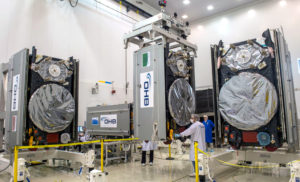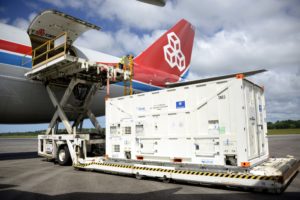
For its fourth launch of the year, Arianespace will orbit four more satellites (satellites 23 to 26) for the Galileo constellation. This mission is being performed on behalf of the European Commission under a contract with the European Space Agency (ESA).
For the third time, an Ariane 5 ES version will be used to orbit satellites in Europe’s own satellite navigation system; with all Galileo spacecraft having been launched to date by Arianespace. Ariane 6 will take over from 2020. Read more…
The four Galileo satellites for Arianespace’s next Ariane 5 mission at the service of Europe’s navigation system are coming together in their flight configuration, while parallel preparations continue with the mission’s heavy-lift launcher.

In the Spaceport’s S1A clean room facility, the four Galileo FOC satellites are prepared for their fit-check evaluation with the mission’s payload dispenser
During pre-flight activity in French Guiana at the Spaceport’s S1A processing facility, these FOC (Full Operational Capability) spacecraft have undergone their fit-checks with the dispenser system to be installed on Ariane 5. Read more…
Galileo satellites 25 and 26 have landed at Europe’s Spaceport in Kourou, French Guiana, joining their two predecessors ahead of their 25 July launch by Ariane 5.

One of the two Galileo satellites 25 and 26 being unloaded from their Boeing 747 cargo jet at Cayenne – Félix Eboué Airport in French Guiana on 1 June 2018. The satellites travel inside protective air-conditioned containers.
The pair left Luxembourg Airport on a Boeing 747 cargo jet on the morning of 1 June, arriving at Cayenne – Félix Eboué Airport in French Guiana that evening. Read more…
Payload preparations have begun for Arianespace’s next Ariane 5 mission in support of Europe’s Galileo global navigation system, with two of the four satellites for launch on this July 2018 flight now undergoing their checkout at the Spaceport.
These two spacecraft arrived at French Guiana’s Félix Eboué Airport earlier this month aboard a 747 cargo jetliner, and were then unloaded and transported by road to the Spaceport’s S1A payload preparation facility. The third and fourth Galileo satellites will be delivered to the equatorial launch base in June. Read more…
A full-scale demonstrator of the thrust chamber for an upper-stage rocket engine incorporating the newest propulsion technologies is being prepared for its first hot firing.
The Expander-cycle Technology Integrated Demonstrator, or ETID, has arrived at the DLR German Aerospace Center test facility in Lampoldshausen for tests. It will help to prove new technologies, materials and manufacturing techniques that offer higher performance at lower cost for Europe’s future launchers.
ETID is a precursor of the next generation of 10-tonne rocket engines. Some of the technologies could also be used on upgrades to the existing Vinci, which powers the upper stage of Ariane 6. Read more…
Europe has four more Galileo navigation satellites (satellites 19–22) in the sky following their launch from Europe’s Spaceport in Kourou, French Guiana at 18:36 GMT (19:36 CET, 15:36 local time), on an Ariane 5 rocket, operated by Arianespace.